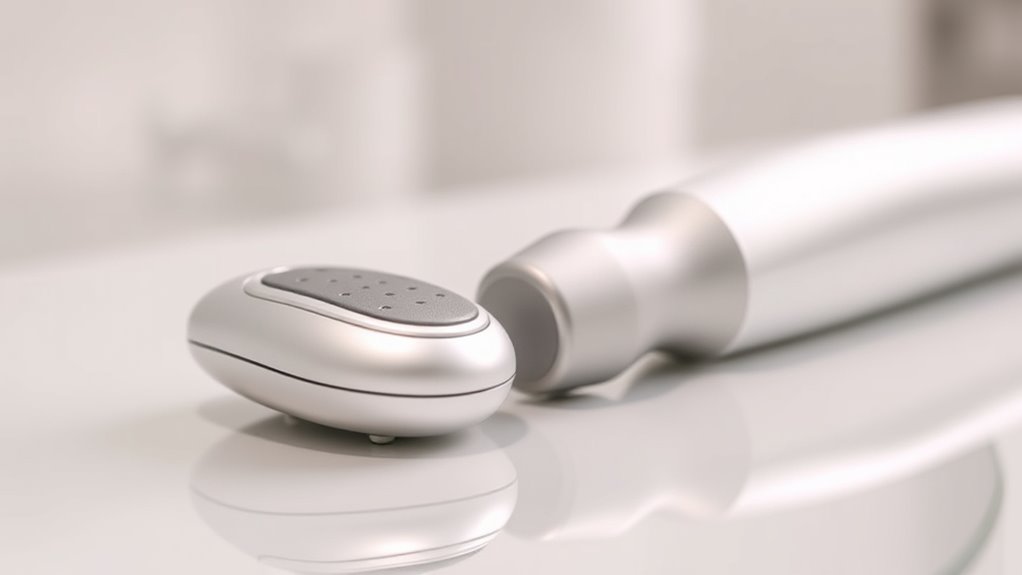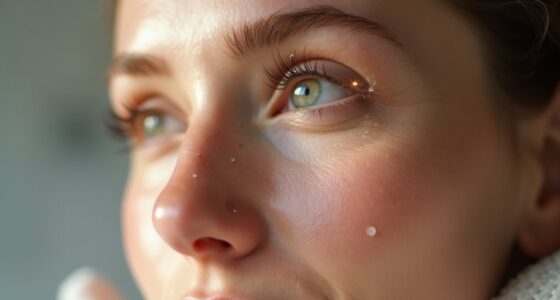Microcurrent devices use low-level electrical currents to stimulate muscles and promote cellular repair, boosting collagen and skin tone. RF wands, on the other hand, use electromagnetic energy to generate heat, tightening skin by remodeling collagen deep within the dermis. Both methods are clinically proven for skin rejuvenation and pain relief, but they work differently—microcurrents focus on muscle toning, while RF provides deep skin tightening. Explore further to discover which approach suits your goals best.
Key Takeaways
- Microcurrent devices promote cellular repair and muscle toning through low-level electrical currents mimicking bioelectric signals, with minimal risks.
- RF wands generate deep dermal heat to stimulate collagen remodeling, providing longer-term skin tightening and wrinkle reduction.
- Microcurrent therapy offers immediate muscle relaxation and pain relief, while RF induces gradual skin tightening over multiple sessions.
- Both technologies are FDA-approved and clinically proven, but RF has a stronger track record for deep skin tightening and tissue remodeling.
- Microcurrent focuses on facial muscle toning and rejuvenation, whereas RF directly targets dermal collagen for skin firmness and wrinkle reduction.
Understanding the Core Technologies
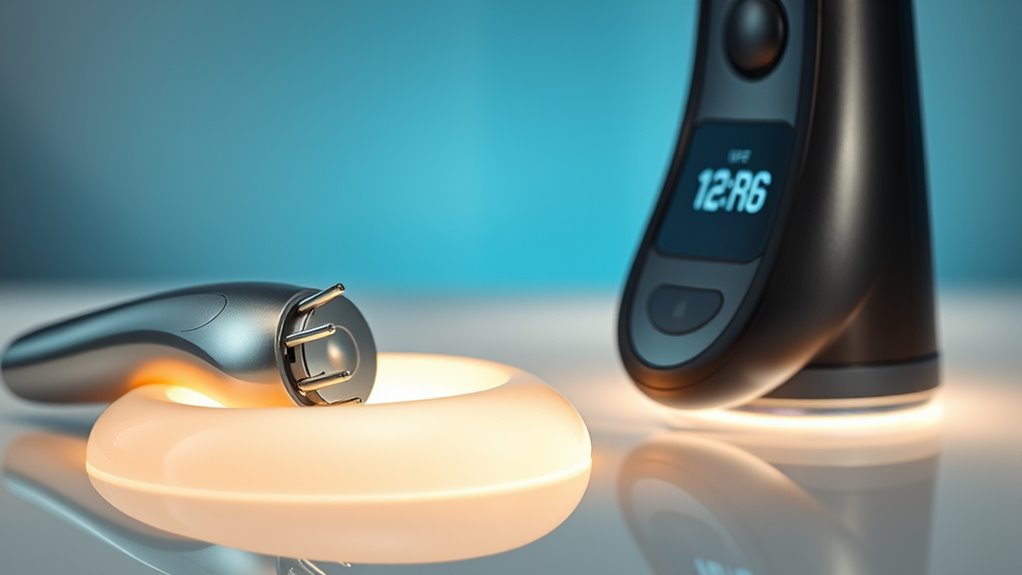
Understanding the core technologies behind microcurrent devices and RF wands is essential to grasp how each method works to improve skin appearance. Microcurrent devices use low-level electrical currents that mimic your body’s natural bioelectrical signals. These microampere currents are gentle enough to be felt as a light flutter, requiring conductive gel to guarantee efficient transmission. They target facial muscles, stimulating toning and lifting, while also boosting ATP production, which energizes cells for repair. In contrast, RF wands employ electromagnetic waves in the range of 0.3 to 10 MHz to generate heat within the skin layers. This heat promotes collagen remodeling and new collagen formation, leading to skin tightening. Unlike microcurrent, RF doesn’t stimulate muscles directly but relies on thermal effects for skin rejuvenation. RF technology has been widely used in dermatology for non-invasive skin tightening procedures, leveraging heat to stimulate collagen synthesis. Additionally, understanding the specific mechanisms of action can help determine which device is most suitable for individual skin concerns.
How Microcurrent Devices Promote Cellular Repair
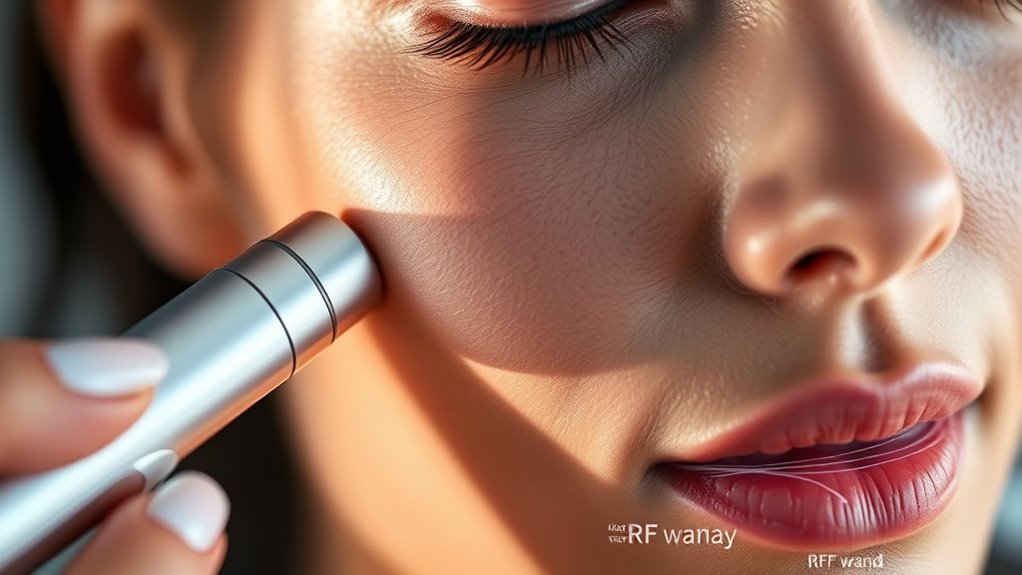
Microcurrent devices boost cellular repair by increasing ATP production, providing your cells with the energy they need to heal. They also mimic your body’s natural bioelectric signals, guiding tissues to regenerate more efficiently. This combination helps speed up recovery and enhances overall skin rejuvenation. Skin cells undergo daily regeneration, and microcurrent therapy supports this ongoing process by stimulating the activity of dermal fibroblasts, which are essential for collagen production and tissue repair. Additionally, the use of pressure points and energy flow techniques can further optimize healing outcomes.
Enhances ATP Production
Microcurrent devices enhance cellular repair by stimulating mitochondrial activity, leading to increased ATP production. They create proton gradients by producing hydroxyl ions and protons at the electrodes, which drive protons across mitochondrial membranes and boost ATP synthesis. The most effective microcurrent intensity around 500 microamps maximizes ATP levels without inhibitory effects. When the current is too high or low, ATP production diminishes, but within the ideal range, amino acid uptake and energy generation improve considerably. Microcurrent also activates mitochondria, enhancing oxidative phosphorylation and supporting tissue repair. Additionally, it modulates cell membrane potential, improving ion exchange and mitochondrial enzyme activity. This combined effect increases cellular energy, promoting faster healing and regeneration. Pinball machines showcase advanced technology and design, illustrating the importance of precise engineering in entertainment devices.
Mimics Bioelectric Signals
By closely mimicking the body’s natural bioelectric signals, microcurrent devices help restore disrupted cellular communication. They generate very low electrical currents (1–999 µA) that resemble the body’s own bioelectric signals, helping normalize electrical patterns in damaged tissues. This stimulation encourages cellular membranes’ electrical activity, initiating healing and repair processes. Utilizing bioelectrical impedance analysis, you’ll find that microcurrent therapy uses principles like Ohm’s Law and real-time feedback to adjust current based on tissue resistance, targeting treatment precisely. Bioelectrical impedance analysis identifies areas of dysfunction by measuring resistance variations, ensuring effective stimulation. This mimicking process activates cellular pathways that promote tissue repair, collagen production, and reduced inflammation, all essential for skin rejuvenation and faster healing.
The Thermal Effects of RF Wands on Skin
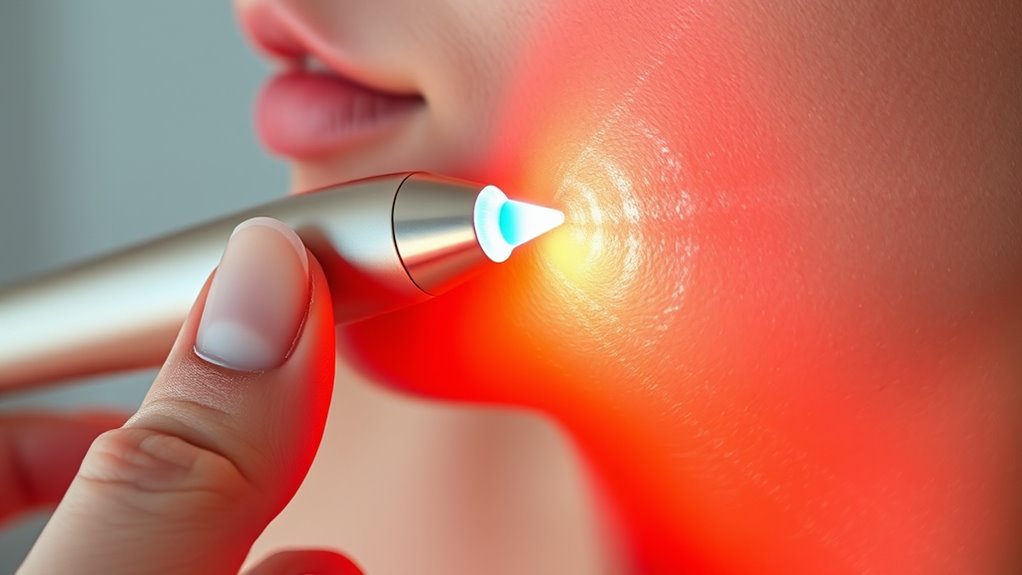
RF wands deliver targeted thermal energy to the skin, raising its temperature to stimulate collagen production and promote skin tightening. They typically heat the dermis above 45°C, triggering collagen remodeling. When temperatures reach between 50°C and 75°C, collagen denatures, causing contraction and restructuring of connective tissue. This process unwinds collagen’s triple helix and breaks cross-links, shifting it into a gel-like state that facilitates tightening. Effective RF devices carefully control heat levels to avoid thermal damage while maximizing collagen benefits. Advanced RF systems use specialized antennas to focus electromagnetic energy precisely on the dermis, quickly increasing skin temperature with minimal invasiveness. This controlled thermal stimulation encourages fibroblast activity, leading to improved skin firmness and reduced fine lines over time. RF hyperthermia can also stimulate increased blood flow and cellular metabolism, further enhancing skin rejuvenation and healing. Proper thermal regulation is essential to ensure safety and efficacy during treatment, preventing potential adverse effects.
Clinical Uses and Therapeutic Benefits
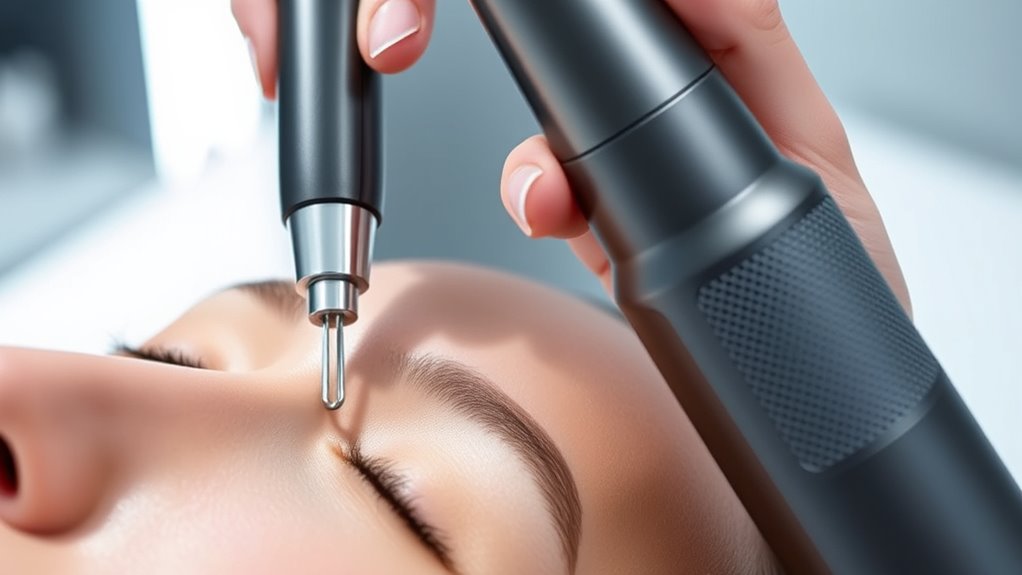
Microcurrent devices are increasingly applied in clinical settings to address pain, injury recovery, and skin rejuvenation. They mimic natural bioelectric signals, promoting tissue repair and reducing chronic pain. You might see them used for conditions like sinus pain, back pain, or rotator cuff tears, helping both acute and chronic injuries heal faster. They are approved by the FDA, indicating a recognized safety profile. Key therapeutic benefits include: – Stimulating facial muscles for lifting, sculpting, and improved muscle tone – Boosting collagen and elastin production for skin elasticity and wrinkle reduction – Enhancing blood flow and lymphatic drainage, reducing puffiness and water retention. Understanding cellular electrical activity is essential for appreciating how these devices promote healing effectively. These devices work by restoring normal cellular electrical activity, promoting healing, reducing inflammation, and remodeling scar tissue—all with minimal discomfort and no need for invasive procedures.
Safety Profiles and Potential Side Effects
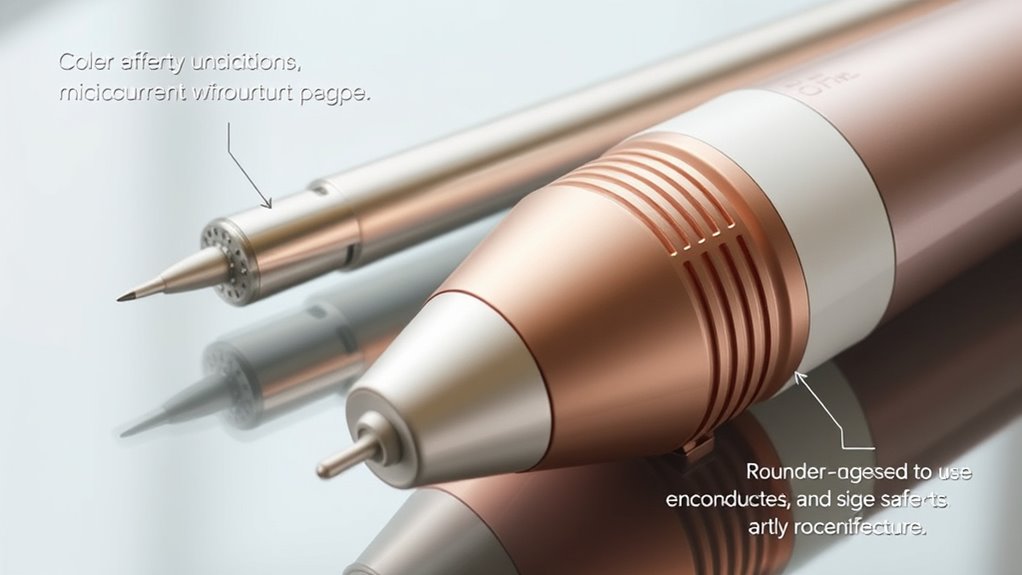
Both microcurrent devices and RF wands are generally considered safe when used properly, but their safety profiles differ due to their mechanisms. Microcurrent therapy has a strong safety record, with minimal side effects like transient tingling or mild discomfort that usually resolve quickly. Serious adverse events are rare, and long-term use shows no significant risks. Modern devices include safety features such as no-shock starts to enhance comfort and reduce risks. RF wands, on the other hand, use high-frequency waves to generate heat, which can lead to redness, swelling, burns, or discomfort if not carefully controlled. Users with metal implants or skin infections face higher risks. Proper calibration and practitioner control are essential with RF devices to prevent thermal injuries, making safety highly dependent on correct application. Additionally, the use of multiple technologies can influence safety profiles, requiring users to understand their specific device functions.
Comparing Effectiveness in Different Applications

When comparing microcurrent devices and RF wands, you’ll notice each excels in different areas like pain relief, skin rejuvenation, and therapeutic uses. Microcurrent often provides immediate muscle relaxation and pain reduction, while RF promotes longer-term skin tightening and renewal. Understanding these differences helps you choose the right tool for your specific application goals. Additionally, RF devices stimulate collagen production by generating deep tissue heat, leading to more sustained skin improvements over time. Moreover, microcurrent technology has been shown to support data integrity and availability, ensuring consistent performance during treatments.
Pain Relief Capabilities
While neither microcurrent nor RF devices are primarily designed for pain relief, each uses different mechanisms that can offer some comfort. Microcurrent delivers low-level electrical currents that promote cellular repair and may reduce muscle tension and nerve discomfort, but strong clinical proof is limited. RF devices generate heat in deeper tissues, temporarily easing soreness and stiffness through increased blood flow and muscle relaxation. Scientific studies have shown that RF heating can improve circulation and reduce muscle tightness, which may contribute to pain relief in some cases. Some key points include: – Microcurrent may help with nerve or muscle tension but lacks robust evidence for significant pain reduction. – RF’s heat effect can alleviate chronic stiffness but isn’t proven as a primary pain treatment. – Both are safer options than stronger electrical therapies, though RF requires caution to avoid burns or discomfort.
Skin Rejuvenation Benefits
Curious about which device offers more effective skin rejuvenation? Microcurrent stimulates facial muscles with low-level electrical currents, leading to immediate lifting and improved muscle tone. RF uses heat to stimulate collagen and elastin, gradually tightening skin over multiple sessions. Microcurrent targets the muscle layer beneath the skin, enhancing contour and firmness, while RF primarily affects the dermis, promoting deep skin tightening. Both stimulate collagen but through different pathways—microcurrent indirectly via muscles, RF directly via heating tissue. Understanding technology differences can help you choose the right device for your skin goals.
Therapeutic Applications
Microcurrent and RF therapies each excel in different therapeutic applications by targeting unique skin structures. Microcurrent devices focus on muscle stimulation, improving facial muscle tone and lift by mimicking the body’s natural electrical impulses. They are ideal for contouring and addressing muscle laxity. RF devices, on the other hand, generate heat within the dermis, stimulating collagen and elastin production for skin tightening and reducing wrinkles. They are more effective for deep skin concerns like laxity and fine lines. Additionally, RF treatments are well-studied and have a long track record of safety and effectiveness in clinical settings. Microcurrent enhances muscle tone and facial contouring. RF promotes collagen synthesis and skin firmness. Combining both offers holistic rejuvenation by targeting muscles and structural skin proteins, creating a comprehensive approach to skin health.
Choosing the Right Device for Your Needs
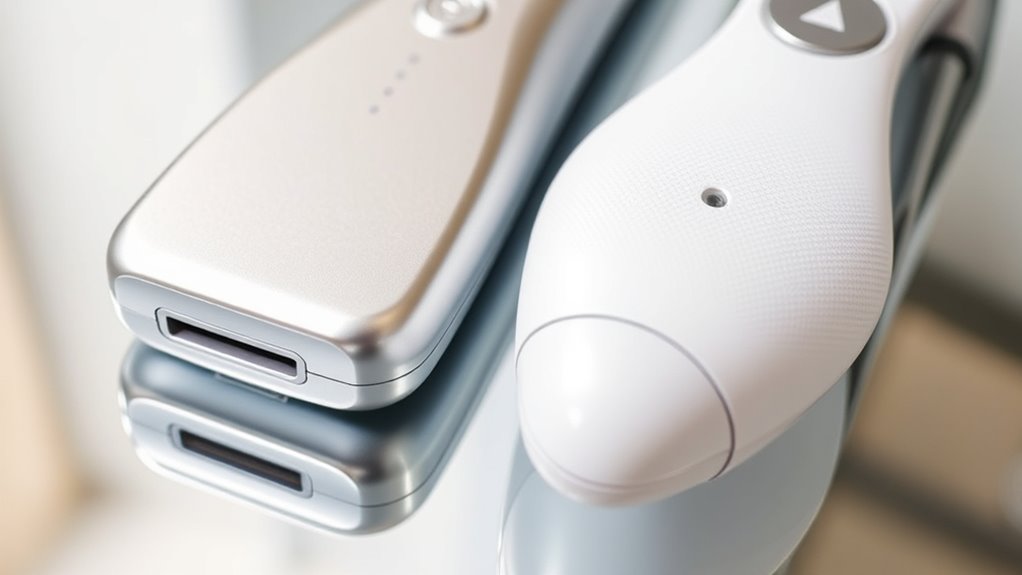
Choosing the right device depends on your specific skin concerns and goals. If you want to lift and tone facial muscles, microcurrent devices are ideal—they re-educate muscle fibers for a natural lift, but results may take weeks. For firmer, more elastic skin, RF wands stimulate collagen and elastin over time, with noticeable tightening after 4 to 6 weeks. If you’re after quick improvements in acne and skin brightness, high-frequency wands offer immediate surface benefits and are painless. Consider your skin type and sensitivities: microcurrent may cause mild tingling, while RF’s heat might not suit sensitive skin. Combining devices can provide extensive results, targeting muscles and skin layers simultaneously. Both technologies target different skin layers for comprehensive benefits. Always consult a professional to choose the safest option tailored to your needs.
Frequently Asked Questions
Can Microcurrent Devices Be Used Alongside RF Treatments Safely?
You can safely use microcurrent devices alongside RF treatments if you follow proper protocols. Alternating treatments on different days helps prevent skin irritation and overstimulation. Both methods target different skin mechanisms—microcurrent boosts cellular activity, while RF stimulates collagen through heat. Monitoring your skin and starting with gentler treatments reduce risks. Confirm proper training and consult professionals for personalized guidance, making combined treatments both safe and effective.
How Long Does Each Treatment Typically Take to Show Results?
Imagine your skin as a canvas, ready to glow. With microcurrent treatments, you’ll see subtle lifting and radiance after just one session, with more noticeable improvements in skin tone, fine lines, and firmness after 1-3 months of regular use. RF wands, on the other hand, often need several sessions over 2-3 months before revealing tighter, smoother skin. Consistency uncovers the full potential of each, painting your youthful glow.
Are There Any Long-Term Health Risks Associated With Either Device?
You wonder about long-term health risks of microcurrent devices and RF wands. Currently, evidence shows microcurrent therapy is safe with minimal side effects, but long-term data is limited, especially regarding DNA or cancer risks. RF wands are generally safe when used properly, with rare side effects like redness or burns. However, both lack extensive long-term studies, so it’s wise to consult healthcare professionals if you have concerns or pre-existing conditions.
Do These Devices Require Professional Supervision or Can They Be Used at Home?
You might wonder if you need professional supervision to use these devices. Generally, lower-risk home microcurrent and RF devices are designed for personal use without direct oversight, but some high-end microcurrent devices for medical purposes require a healthcare professional’s supervision. Always follow the manufacturer’s instructions and consult a healthcare provider if you have medical conditions or concerns. Proper training can help guarantee safe and effective use.
What Maintenance or Special Care Is Needed After Each Treatment Type?
After your treatment, gentle care fosters skin’s quiet renewal. For microcurrent devices, wipe them with an alcohol-free disinfectant, store in a dry place, and handle cords with care. With RF wands, cleanse your skin softly, apply soothing serums, and shield yourself from prolonged sun exposure. Both require careful cleaning, proper storage, and mindful use to keep them performing well, ensuring your skin benefits from each session while prolonging your device’s lifespan.
Conclusion
Think of microcurrent devices and RF wands as two different artists painting your skin’s portrait. Microcurrents gently whisper to your cells, encouraging repair and renewal like a delicate brushstroke, while RF wands heat things up, sculpting with a fiery touch. Choosing between them depends on your goals. Either way, you’re guiding your skin’s masterpiece—so trust your instincts and pick the tool that resonates with your vision for a radiant, revitalized you.
